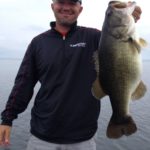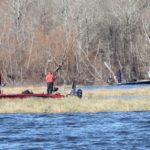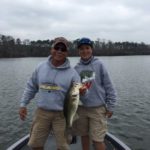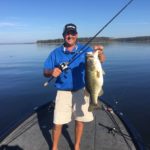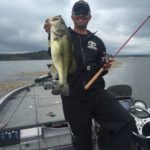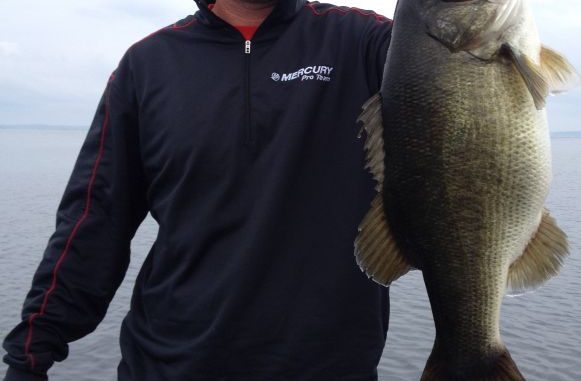
Toledo Bend is still in the throes of the annual spawn, which means double-digit bass are more accessible than during any other time of the year. And these guides share how to put your lure in front of those fish.
It’s a big lake and it’s chock full of bass, but Toledo Bend is no gimme — even with its well-merited title of the nation’s top lake two years running.
Fish there and you’ve definitely selected a target-rich environment: You simply have to play her game, and that starts with understanding what to expect from this Sabine River gem.
Straddling the Louisiana/Texas border, Toledo Bend annually attracts the nation’s top talent, with frequent stops by the major bass tournament circuits.
But no one knows this lake better than the folks who live on or near her shores and spend the better part of their year bending rods on Toledo Bend brutes.
Talk to anyone in the know and a common theme will be the accelerating influence of atypically warm conditions delivered by the year’s first quarter.
That being said, here’s a preview of coming attractions, as told by some of the anglers who know her best.
Dave Mansue, Dave Mansue Guide Service
Outlook: The story starts with a lake level about 3 feet below normal pool (172 feet), a fact guide Dave Mansue said allows for plenty of room to handle any heavy spring rains without any great disturbance.
Mostly warm weather has pushed water temperatures into the mid- to upper-60s already, but Mansue said anglers should pay close attention to the duration and severity of any April cold fronts — particularly the overnight lows.
If nighttime temps take a significant dip, that will push spawning fish off the beds and put the brakes on any advancing prespawners.
Seasonal tactics: Mansue said he loves to target commonly overlooked fish.
“A lot of people will go down the hay grass and look for fish that are spawning on the back side of that grass closer to the bank,” he said. “I like to catch those fish that are staging on the outside of the hay grass.
“Most people are looking for the fish they can see; I like to fish for the ones where I can’t see them and they can’t see me. Typically, that’s going to be in a little deeper water in that 3- to 5-foot range.”
Wacky-rigged Senkos and lightly-weighted, Texas-rigged Zoom Baby Brush Hogs work well in calm conditions.
But let some wind bluster the area, and Mansue moves to reaction baits. Specifically, he likes a 4.3- or 4.8-inch swimbait.
Preferring white lures on cloudy days or silver flash under sunny skies, he rigs his swimbait weedless on a belly-weighted hook, as this helps avoid tangles in trees.
Mansue said this tactic yielded an 11-pound, 3-ounce toad last spring.
He likes the lake’s lower end from Indian Mounds to the dam because a resurgence of grass keeps these waters clean.
Another productive tactic here: Tempting post-spawners by walking topwaters across long points with grass.
Key considerations: “This time of year, you’re going to hit cloudy days (and) sunny days,” Mansue said. “You have to adjust to those conditions. The majority of the fish are going to be pointed toward the bank, and we have to remember that.
“As the days goes on, typically they like to move shallower and shallower, so you have to move with the fish. Keep trying different depths until you get a few bites and they tell you where they’re at.”
The key depth can change during the day.
“They move quickly this time of year, so you might catch them in 10 to 12 feet of water in the morning, and then in the afternoon, they’re going to be in 3 to 5 feet,” Mansue said.
Stephen Johnston, Johnston Guide Service
Outlook: The lake’s current level of about 3 feet below normal starkly contrasts the high water of the past two years, which allowed bass to venture into the shoreline cover such as hay grass, buck brush, cypress and willows.
Johnston said the lower water levels have moved the game outward to what was once deeper grass edges.
Here, he expects to find a mix of spawn stages.
“We already had one big wave of fish that spawned in February, (and) we (should have) another big wave in March,” Johnston said. “So in April we’ll have the next wave coming, but we’ll also have a lot of post-spawn fish.
“And as warm as it has been for us here, you’ll have a lot of those postspawners getting more in that 8- to 12-foot range. Those fish are going to be a bigger play this April than they have been in several years.”
Seasonal tactics: When he’s looking for those bass that have pushed off the bank, Johnston knows he can do well by cranking 6- to 10-foot water with a Strike King Series 5 or a 3XD.
He’ll also throw a Carolina rig with a Strike King Game Hog, Caffeine Shad or Zoom Fluke. Watermelon red and watermelon seed are local color faves.
“Those post-spawners are trying to build their bodies back up after the spawn,” Johnston said. “They want to chase, but they don’t want to chase something too much.
“You will have some action on the crankbaits, but those slower-moving baits will be really good. I like Carolina rigging with a Game Hog on a 2-foot leader.”
The C-rig is a workhorse this time of year.
“You’ll catch prespawn fish, you’ll catch postspawn fish and you’ll catch fish that are spawning,” Johnston said. “That Carolina rig is just an all-around awesome option for April.”
He said he’ll typically target new growth hydrilla standing about 4 inches tall in 3 to 4 feet of water.
He suggested positioning the boat in 7 to 8 feet of water, casting the C-rig to that inside grass line and tracing the young hydrilla growth.
“This works for spawners, prespawners and postspawners,” Johnston said. “Really, those fish get grouped on these place with some coming, some going and some just kind of sitting there.”
Johnston likes the Indian Mounds area and Toro Bay because these hotspots offer great opportunities for quantity and quality.
He favors the south end of the reservoir in April because, with a lot of fish still coming from that deep water, this is where he’s likely to find the greatest level of opportunity.
“It’s like a traffic jam, with them coming and going,” Johnston said. “A lot of times, you’ll catch 2-pounder, 2-pounder and an 8-pounder.
“Those fish are really mixed.”
Key considerations: The guide noted that, in terms of weather, April is usually one moody little diva. Several days of cozy, consistent conditions can be rocked by meteorological mayhem — and bass do not take kindly to such changes.
“We have a lot of severe storms with 30 to 40 mph winds, big rain and lightening,” Johnson said. “When you have those bad storms come through, it really shocks the fish. They do not like that lightning or that big wind.
“Also, every now and then in April, we still get one of those pretty good cold fronts. Whenever you get a big scenario like that, it will take one to three days to calm down and get back to normal.”
Darold Gleason, South Toledo Bend Guide Service
Outlook: “I expect that 75 percent of the bass will be post-spawn, and the shad spawn is going to be a big player in April and there may be some still guarding fry,” Gleason said. “Due to the mild winter, everything is ahead of schedule.”
Seasonal tactics: This guide looks for shad spawns in shallow and deep scenarios. The former usually means hay grass or clay points, while the latter comprises hydrilla lines in 4 to 8 feet of water.
“On the hay grass and clay points, you throw white-bladed jigs or swim jigs with white swimbait trailers,” Gleason said. “On the deeper spots, I like to throw a ¾-ounce spinnerbait around hydrilla lines in 4 to 8 feet (depths).
“You want to fish that spinnerbait kind of fast. You’re not burning it to the surface. That’s why I throw a ¾-ounce bait — it’ll get down 3 to 4 feet, and you can roll it pretty good.”
Gleason said the spinnerbait’s hefty profile also appeals to the heightened aggression common to bass targeting shad spawns.
This bait will catch numbers, but it also gives you a legitimate shot at a two-hander.
For fry guarders, Gleason likes a bluegill pattern swim jig because imitating the top threat to a proud parent’s offspring is sure to stimulate violent response.
He expects to find clusters of tiny bass huddling near cover like hay grass or shallow stumps.
When he spots guarding bass, Gleason utilizes a stealthy strategy to ensure himself maximum opportunity.
“If I can see them, I’ll flip a V&M Flat Wild (creature bait) to them,” he said. “I’ll try to slip on down the bank and not spook them, but then turn around and come back to make a long flip to the area where the fry are holding.
“Usually, the fry are around a piece of cover and, as long as you don’t spook them, the male bass will stay near the area. If you can creep on by them and turn around without them knowing, a lot of times you can catch them.”
He said anglers will find plenty of shad spawn and fry guarding opportunities from the Pendleton Bridge south.
The lake’s wider and progressively deeper south end lags behind the flatter north end, where many of the fish will be transitioning to summertime patterns.
Key considerations: “The biggest thing is being quick to move in the morning,” Gleason said. “When you find that bite, it happens very fast for you. So if you’re not seeing activity and you’re not catching fish, move.
“It’s happening somewhere every single morning — you just have to find it and capitalize on it.”
